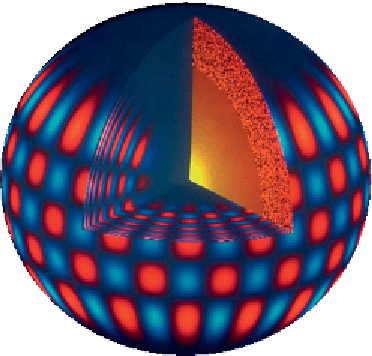Geoscience Reference
In-Depth Information
Box 7.1
Helioseismology
Helioseismology is the study of wave motions inside the Sun as measured
from images of the solar surface. By monitoring these waves it is possible to
obtain information about the solar interior, just as the study of seismic waves on
Earth can provide insights into the structure of the interior of Earth. While the
source of seismic waves is earthquakes, waves in the Sun are produced by
motions in the convective region beneath the solar surface, an essentially
continuous source. That is, when an earthquake occurs, the Earth can ring
like a bell, struck once. In contrast, the Sun is like a bell that is being
continually struck. Thus the solar waves are continuously present in images
of the surface.
There are a number of different dominant wave modes that the Sun can
oscillate in, and thus the measurement and analysis of images of the Sun can be
quite complex. The desire is to have continuous 24-hour coverage of the Sun so
as to be able to detect and measure solar modes over a wide range of their
expected frequencies. Beginning in 1979, before there were continuous satellite
images of the Sun over a 24-hour basis, the pioneering measurements by Martin
Pomerance, Eric Fossat and Gerard Grec opened the South Pole to helioseismic
studies. Observations from the South Pole in summer were used subsequently to
good advantage to advance signi
cantly the study of helioseismology. In
particular, the South Pole measurements produced fundamental advances in
understanding the internal sound speed and the internal rotational properties
of the Sun.
Figure 7.11
Waves resonating in the
interior of the Sun. (Credit: National Solar
Observatory)






Search WWH ::

Custom Search